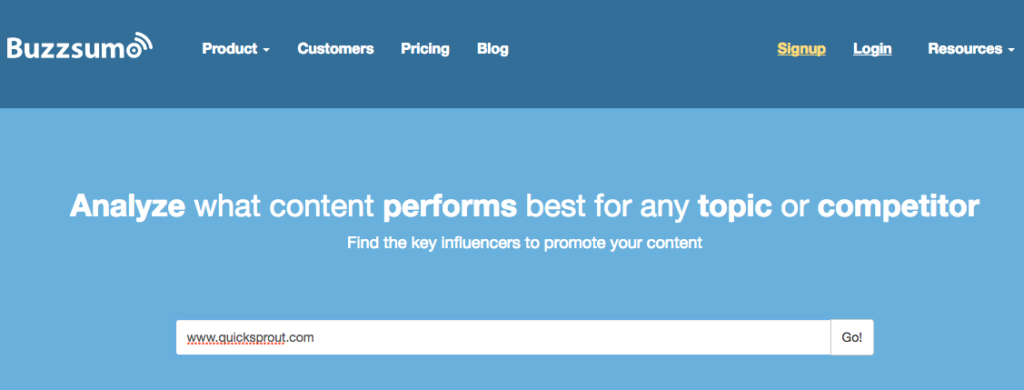4 years ago this caught my eye…

I distinctly remember being blown away that someone would have the audacity to sell 1 hour of coaching for $1,000 and being even more surprised that people would actually pay that much.
The thought of charging even $50 or $100 an hour seemed absolutely insane.
$1000? Ludicrous.
But shortly after this, I hired my first coach and saw how much momentum and impact working with someone 10 steps of head of me could generate.
This gave me the initial spark to think about getting into coaching myself. I wasn’t an expert, but I was good at a handful of things and I often got asked about those things.
Fast-forward 2.5 years. I’ve been able to work with 300 individual coaching clients 1:1 and it’s been one of the most rewarding things I’ve ever done.
The coaching program has generated just over $500,000 in revenue and we’ve seen our hourly rates climb from $50 per hour to $5,000.
I get asked on a weekly basis about the program, how we run it and how we get clients. Today I’m going to show you everything we’ve learned and how you can do the same thing.
How we started our coaching program
It was March of 2014 and the Videofruit blog was just a few months old.
At that point, I had 1,200 email subscribers and was starting to make video tutorials for businesses using the Santa Claus Formula.
I’d seen Noah’s $1,000-per-hour coaching offer several months earlier and listened to an interview between Stu McLaren and Andrew Warner on Mixergy in which they discussed membership sites.
After hearing that podcast, I starting noodling on how I could validate that a membership site would be something my list would buy without going through the entire process of building a membership site.
That’s when it occurred to me that I could make sure people would be willing to pay a monthly fee in exchange for information, by offering a coaching program. It would be higher touch, but I wouldn’t have to spend months creating something people might not even want.
I quickly wrote an email (more on that in a minute), sent it to the list and the 5 coaching spots sold out in under 2 hours @ $100 each.
Here’s the email:

And that’s how everything started.
In the rest of this article, I’m going to share the 6 steps we went through to start and manage our program.
Step #1: Pick the exact problem your coaching program will solve.
Step #2: Decide on the structure of your program.
Step #3: Collect 2 stories from people you’ve helped.
Step #4: Decide on your pricing structure.
Step #5: Set up your internal processes and systems.
Step #6: Launch your coaching program.
I hope this helps you!
Step #1: Pick the exact problem you are going to solve.
The first thing I did before launching my coaching program was to pick the exact problem I wanted to help people solve.
In my case it was the super broad problem of getting “unstuck.” In hindsight I should have made this more specific, but alas.
You have to do the same. Before you can sell anything, you have to be able to show people how the thing you are selling will make their life better.
Here are three methods to help discover that pain point:
Method #1: Identify the #1 question you get asked the most.
Think of the people you interact with on a daily basis:
1. Friends
2. Subscribers
3. Customers
4. Family
What is it that people turn to you for?
How do you find yourself currently “coaching” people?
What is the common pain point for those who seek your advice?
This is your first and simplest place to look for the pain point for your coaching program.
A quick way to find this out is to go through your last 50 sent emails and search for recurring topics or questions that you are answering.
Method #2: Sample your contemporaries.
You can also look to those who are in a similar market as you and find the biggest pain point they are solving.
Here’s how you can do this…
Go to BuzzSumo.com and type in the name of someone who is a leader in your niche:
Look at their most-shared blog post.
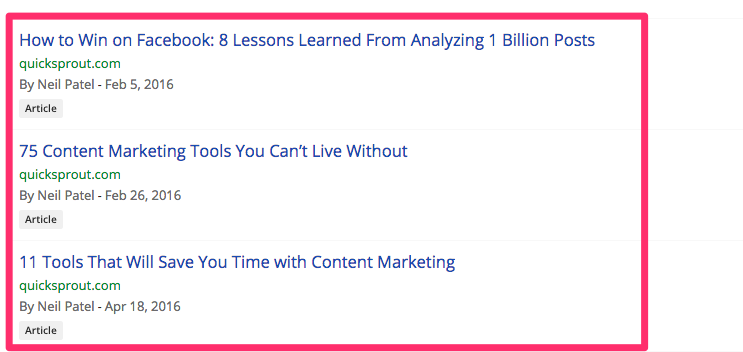
Examine their top 15 most shared articles.
What is the problem that this blog post solves?
Chances are, if your site is in a similar market, your audience has the same problem.
Method #3: Look at your most popular content
There are a few different ways you can figure out what your most popular blog posts are.
I recommend trying these methods only if you have been writing and publishing for at least 3 months.
THE FIRST WAY
Just like you did for your contemporaries, go to BuzzSumo.com and type in your website. With their free trial, you can see which of your blog posts have the most social shares.
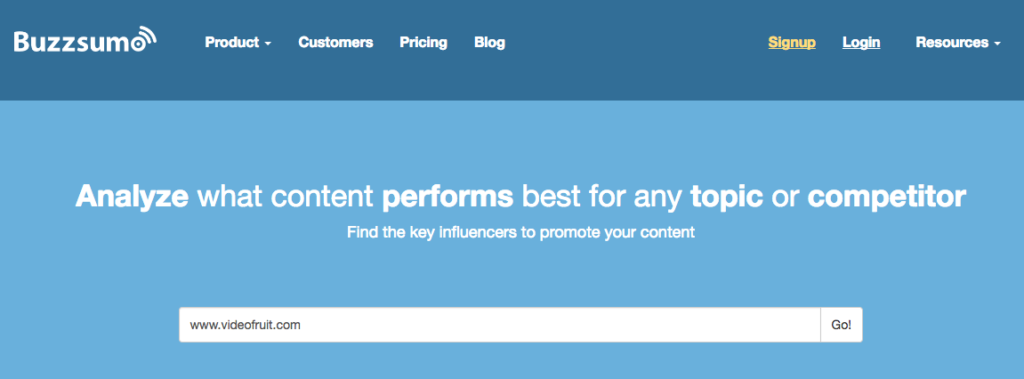
THE SECOND WAY
Log into your Google Analytics account and look up your traffic the past 12 months. Which blog has the most traffic?
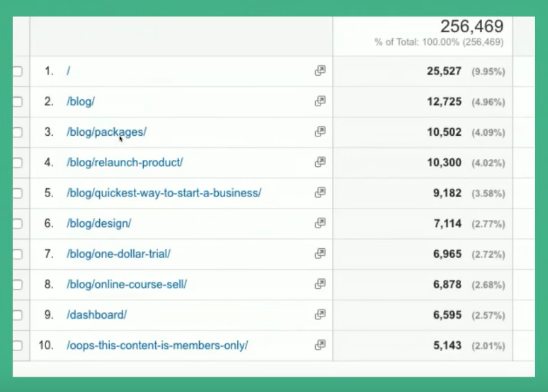
THE THIRD WAY
Log in to your email service provider (like MailChimp, ConvertKit, or Infusionsoft) and look at the past year’s emails. Which blog posts have people clicked on to read the most? In other terms, which blog posts have the highest click-through rates?
Now that you have a sample of your most popular blog posts, evaluate them. Is there a common theme? What tends to be your most popular content?
What is the pain point that people have, the one that they look to your blog to solve?
…
Once you’ve done your research, it’s time to pick the problem you are going to solve!
You may not be 100% convinced of the best problem to solve, but that’s ok. Go ahead and pick one. Go with your gut and pick the one that stands out the most. Don’t overthink this step: You can always change your mind later
Your Action Items
Action Item #1: Do in-depth research to discover the pain point that your coaching program will solve.
Action Item #2: Once you’ve done your homework, choose one specific pain point.
Step #2: Decide on the structure of your program.
Before we launched our coaching program, we had to decide what it would actually include.
Our coaching program includes the following:
1. One monthly coaching call via Skype
2. Video recording of the call for the client to review any time
3. Weekly accountability emails sent to the client each Friday to check on progress
4. Unlimited priority email access to me and the Videofruit team to answer any questions the client has
5. Book of the month mailed to the client’s house each month (along with my personal notes and highlights from the book)

You’ll need to decide what your program will include as well.
What would be the most helpful and most likely to cause your clients to be successful?
Here are some questions to get you thinking:
• An application?
• Pre-coaching homework?
• Phone calls? How many?
• Skype or Zoom calls? How many?
• Video recordings of your calls?
• In-person coaching? When, where and how?
• Action items to complete?
• Some kind of teaching or material?
• Email encouragement/reminders? How often will you send them?
• Access to you via phone/email/Skype/text/Facebook Messenger? How much access?
• Physical touch points like snail mail, monthly book gift, physical welcome packet, etc.?
There are two things to keep in mind when deciding on the structure of your program:
1. Your #1 goal is to keep your clients on track with their #1 goal. What do you need to have in place to make sure that happens?
2. Keep it simple. Don’t over-complicate this process and don’t add in more work for yourself if it isn’t actually going to help the client. Just choose the basics for your program. You can always add more later if you realize it is needed.
Your Action Item: Decide on the format and structure of your coaching program.
Step #3: Collect 2 stories from people you’ve helped.
One key lesson I learned is that the most effective way to get new clients in our coaching program was by telling the stories of people I had helped in the past.
In the beginning that can be tricky because you might have not ever formally coached someone.
But it’s highly likely you have been informally coaching for years.
That could come in the format of free advice to friends or family. It could happen in articles you’ve been writing or help you gave someone in a side convo over coffee.
Here is the testimonial I used when I first launched my coaching program:

Jacqueline and I had had a short 15-minute Skype call a few months before where I’d helped her for free. When I asked her to give a short testimonial, she was happy to.
Your Action Items:
Action Item #1: Gather 2 client success stories from those who have worked with you previously.
Action Item #2: If you don’t have ANY success stories of people you’ve helped, reach out to a few friends or your most loyal readers and offer them a free session. Then follow back up in 7 days to check on their progress and ask for a quick blurb.
Step #4: Decide on your pricing structure.
Now you need to set your pricing.
I recommend starting out on the lower end with your pricing so you can answer a few important questions first:
Question #1: Do I actually enjoy coaching?
Question #2: Can I get clients into my program fairly easily?
Question #3: Are my clients happy and getting good results?
Once you’ve successfully brought in your first batch of students, you can gradually raise your prices with new clients.
Our monthly price started out at $50 per month and now is at $5,000 per month.
Your pricing progression might look something like this:
FIRST LAUNCH: $50 to $100 per month with 5 spots available
SECOND LAUNCH: $150 per month with 5 more spots available
THIRD LAUNCH: $250 per month with 5 more spots available
Our current pricing:
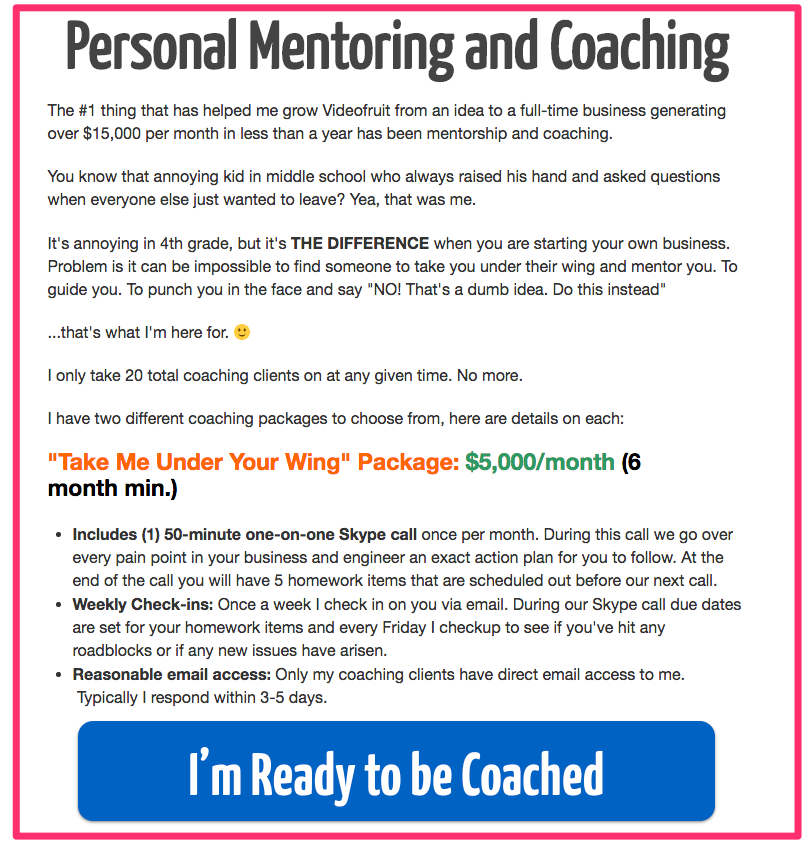
We’ll get into launching your program in the next step, but one thing that’s worked well for us is limiting the number of spots we offer in the first launch.
In our first launch of the program, we only offered 5 spots. This created a sense of urgency and scarcity as well as limited the downside in the event that we hated coaching or were terrible at it.
Your Action Item: Decide on the starting monthly price for your coaching program.
Step #5: Set up your internal processes and systems.
Before you’re able to start accepting payment, you need to set up the back end for accepting your payments and have the tools in place to organize your coaching program’s launch.
Here are some of the tools we use and recommend for launching your coaching program:
Gumroad: Gumroad is a simple-to-use payment system that will allow your customers to sign up for your program and be billed on a monthly, recurring basis.
One nice thing about Gumroad is you can set up payment plans in just a few minutes and it handles all of the recurring monthly payments as well.
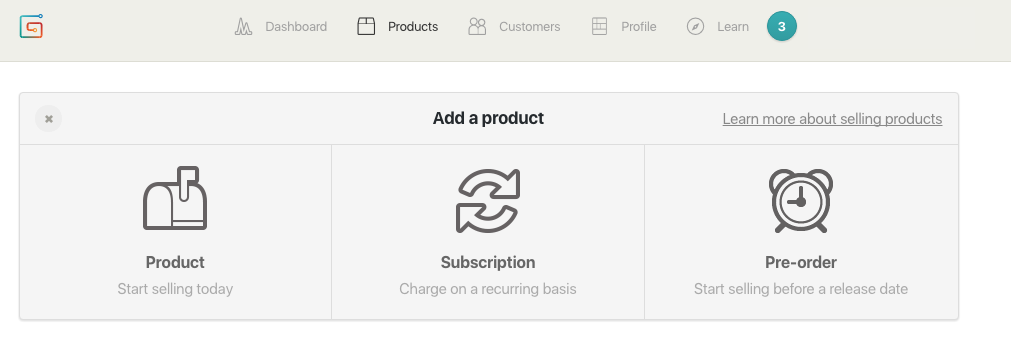
HelloSign: If you want to establish a formal contract for your program, you can send your contracts and have your clients sign online using HelloSign.
We never have had our clients sign a contract of any sort, but there are some scenarios and industries in which this makes sense to do. HelloSign is one of my favorite programs to handle that kind of thing.
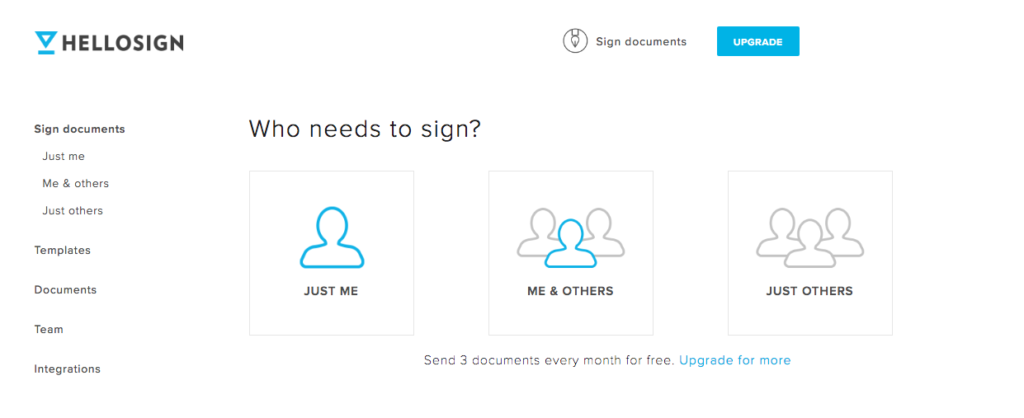
Typeform: Typeform is an easy-to-use form building tool. Once your clients sign up for your coaching program, you can use this free software to ask introductory questions.
One thing you’ll definitely want to have each new client do is to fill out an in-depth onboarding survey. We’ve used a variety of form services for this but Typeform is my personal favorite.
Here is a snapshot of an older version of our onboarding survey:
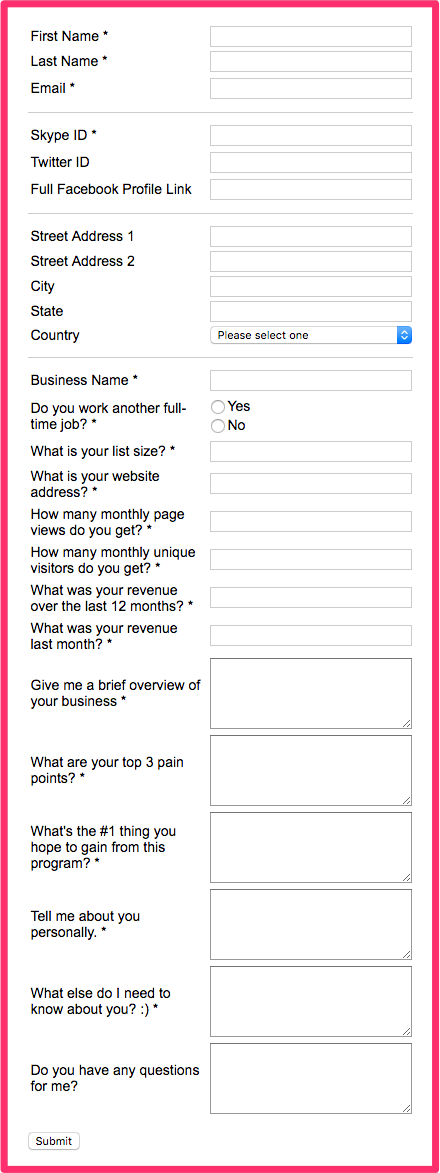
Your Action Items:
Action Item #1: Walk yourself through the processes your coaching clients will follow, from signing up to making payments to completing questionnaires.
Action Item #2: Make sure you have all of your back-end processes in place and tested before launching your program.
Step #6: Launch your coaching program.
Let’s quickly recap what we’ve talked about so far:
1. Pick a specific problem to solve.
2. Choose your program structure.
3. Gather 2 testimonials.
4. Decide on your pricing.
5. Set up your back-end systems.
All of these steps should take you no longer than 34 to 48 hours to complete.
Don’t overthink things. Don’t spend weeks getting these things configured. You can make your systems perfect later; for now, focus on getting a minimal, viable version up.
Now it’s time to launch your coaching program.
When I launched my coaching program, I spent 4 hours writing one email and sent it out on a Sunday night at 7 PM.
This doesn’t have to be complicated.
I suggest planning two emails and adjusting if your 5 open slots sell out quickly.
Here is what that sequence looks like:

Having a limited number of slots in the program as well as a closing date gives you two strong pieces of urgency to use (if you don’t immediately sell out spaces).
Let’s go over each email.
Email #1: The Open Cart Email
Recommended send time: 11 AM central time on a Tuesday, Wednesday, or Thursday
Purpose of the email: Use this email to introduce your coaching program and inform your readers of the 24-hour availability for your coaching program.
Example email content:
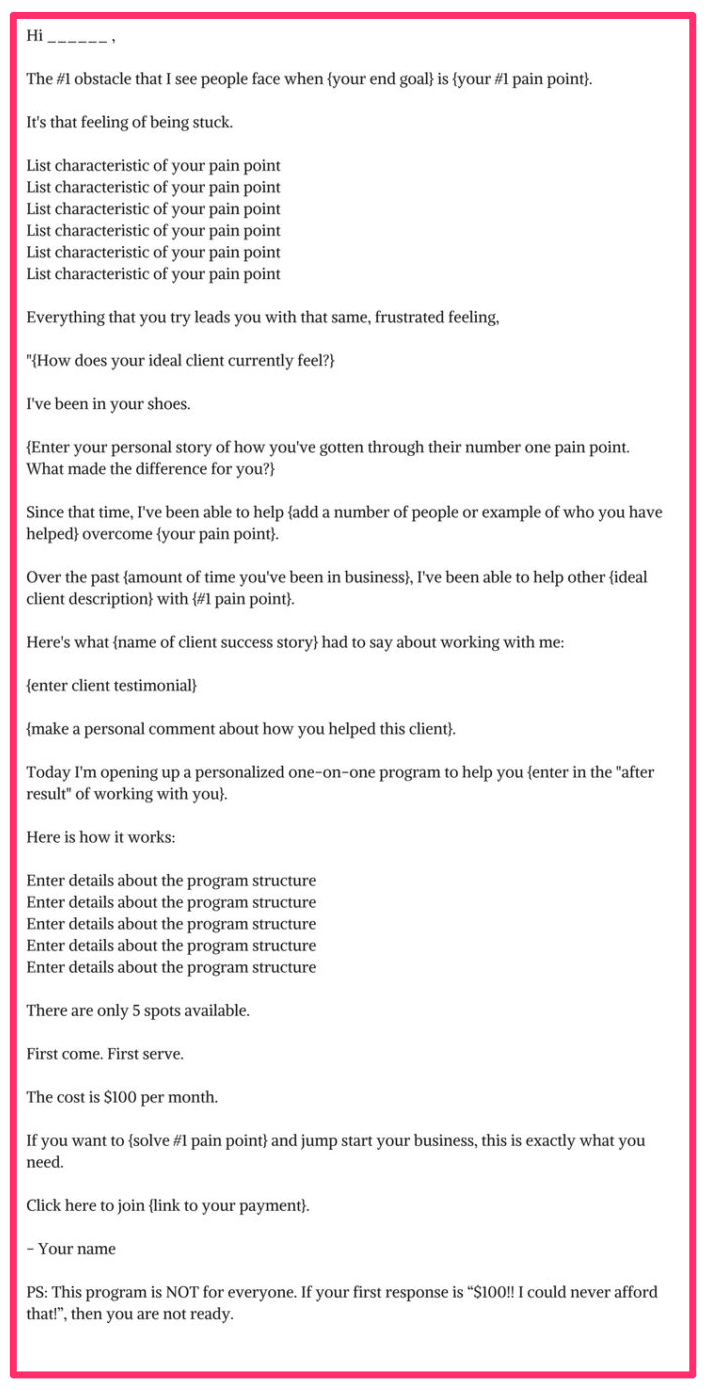
Email #2: The Closing Cart
Recommended send time: 10 AM central time, one day after the open cart email
Purpose of the email: Give your email subscribers one more opportunity to join your coaching program before they miss out.
Example email content:
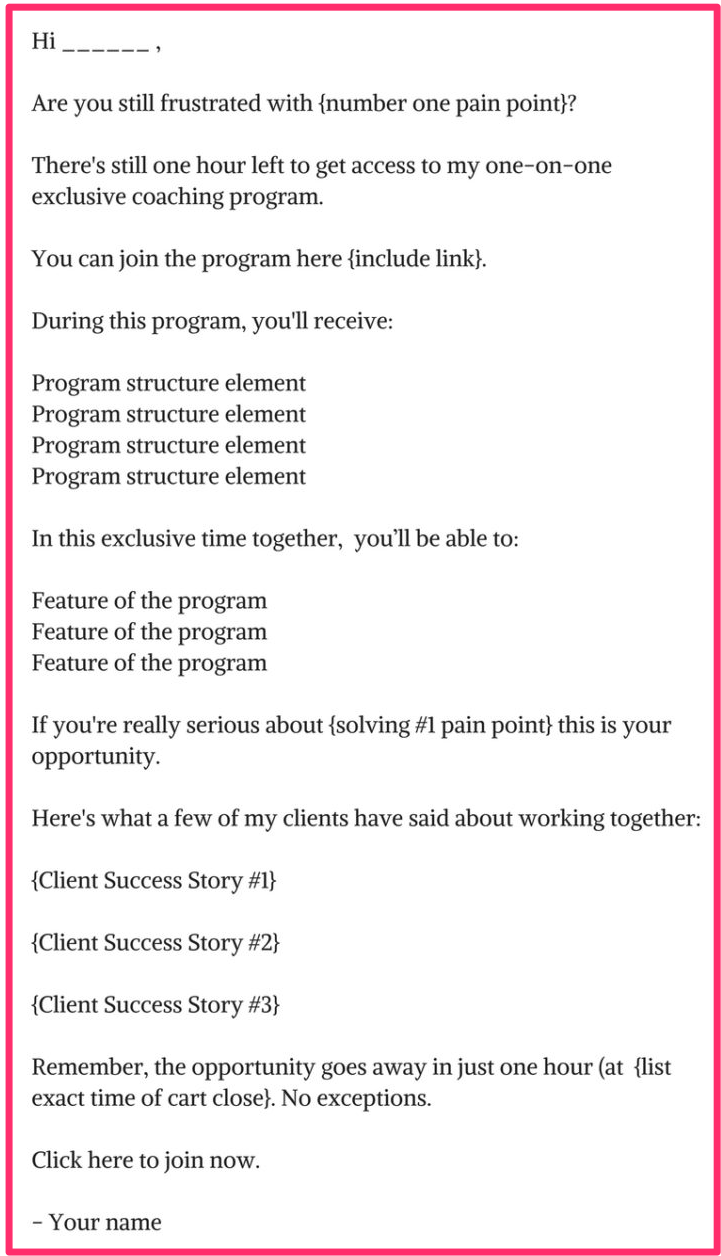
Your Action Items:
Action Item #1: Send an “open cart” email to launch your coaching program.
Action Item #2: Allow people to sign up for your coaching program for 24 hours.
Action Item #3: Send a “closing cart” email an hour before closing your program.
Action Item #4: Follow up immediately with every client who signs up for your program.
A few random questions we’ve been asked about our program
Here are a few of the main questions I get asked when I help others develop their own coaching programs:
Question #1: When I raise the prices of my coaching program every few months, do my original clients “lock in” to their price?
Answer: I usually allow my clients to stay on their current pricing for one year before moving them up to the current pricing plan. Most clients will stop your program when you raise the price. This is one of those situations you’ll have to navigate with care.
Question #2: How long does your coaching program last?
Answer: I ask my clients to sign up for a 6-month commitment. This is a good amount of time to really see the big results from working with me. I let clients work with me beyond 6 months if they would like to continue to do so.
Question #3: How many email subscribers should I have before launching a coaching program?
Answer: I normally recommend not selling anything to your list before you’ve reached 1,000 email subscribers. That said, I’ve seen coaching programs launched with less than 500 subscribers be successful. I highly recommend that you have some kind of history of giving value to your list before trying to sell anything to it.
Update
Since I wrote this article last week, a handful of you have reached out and let me know that it gave you the kick in the butt needed to start your own coaching program.
A lot of time I write articles like this, and out of the of all of the people that read them no one actually takes action. That’s kinda depressing.
So, when I get emails from people that hustle and execute, I get excited.
There were two main questions that people have on executing a coaching program:
Question #1: What if I have NO email list?
Question #2: What if I have a super-small email list? Will it still work?
So, I wanted to write a quick update and answer those two questions.
First, What if I have a super-small email list? Will this work?
Everyone meet Matty.

Matty blogs about sales strategy for business owners. Two weeks ago he read this article, took his email list of 350’ish people and executed the strategy and now is making $2,800 per month from his coaching program.
So, will it work even if you have a small list? YES!
Here is how Matty did it:
A few months ago Matt was completely starting from scratch, no email list, no website…nothing.
So he started by emailing his friends and family.
It’s often overlooked, and we might not think that our friends and family would never be our ideal client. But they are the people that support and believe in you – which means that they’ll likely tell everyone they know about the cool things you are up to.
So, that’s where Matty started.
Here’s a sample of what he sent out to his friends and family:
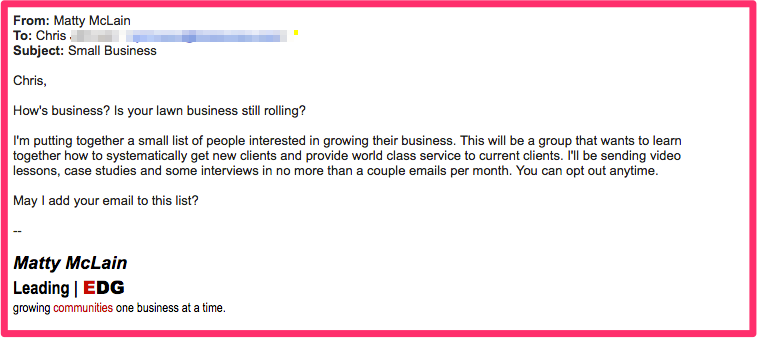
He then asked his friends and family to refer people to him that might be interested in his business as well.
Here’s an example of an email sent by a friend, referring Matty to them:
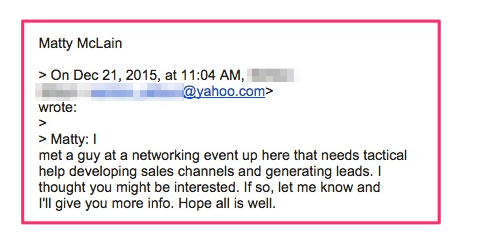
Whenever Matty got copied on an email like this, he would make sure to follow up with the person, like this:
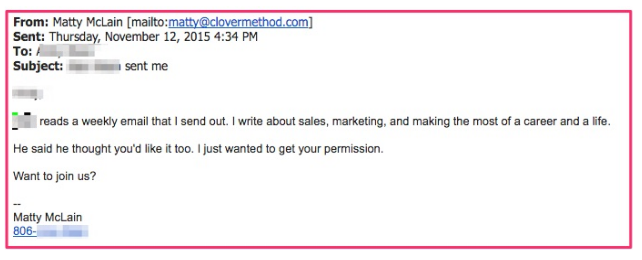
Normally through reaching out to friends and family, you can expect to gain 100 or so email subscribers.
In a little over 30 days Matty was able to hustle and get his list to 355 subscribers.
What does all of this have to do with building a coaching program?
1. Matty didn’t have an email list
2. So he spent a few days quickly growing his list.
Then when this blog post came along he used that list to launch his coaching program.
Here’s the email that Matty sent out to his 355 subscribers last week announcing the coaching program:
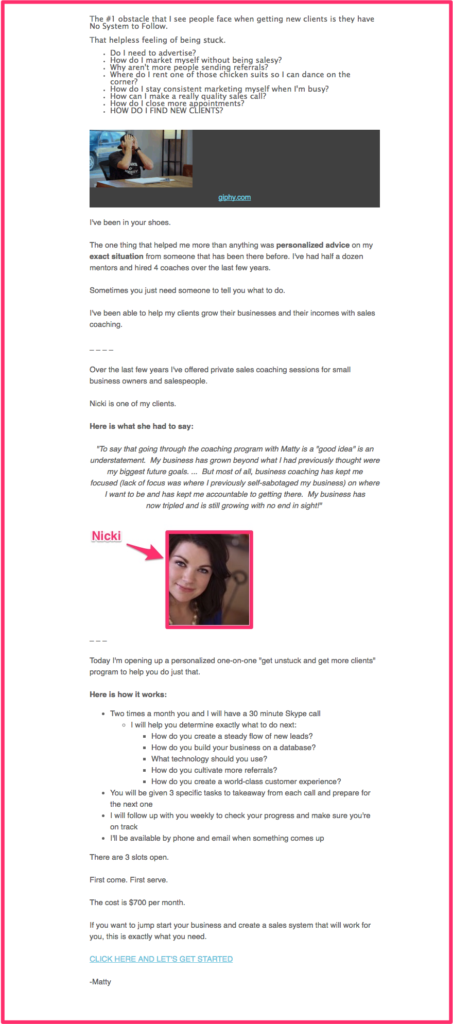
Within 10 minutes, he sold his first seat in the program @ $700 per month.
BOOOM!
But then… crickets.
Matty heard nothing for the next 24 hours. No inquiries. No sales. Nothing happening at all.
He questioned whether or not he should even send out his close cart email. So here’s what he did:
I said “screw it” and sent it. Three more people signed up within hours of that second email.
Matty’s close cart email made people realize that his offer was going away, and that they better act soon.
Here’s the close cart email that he sent:
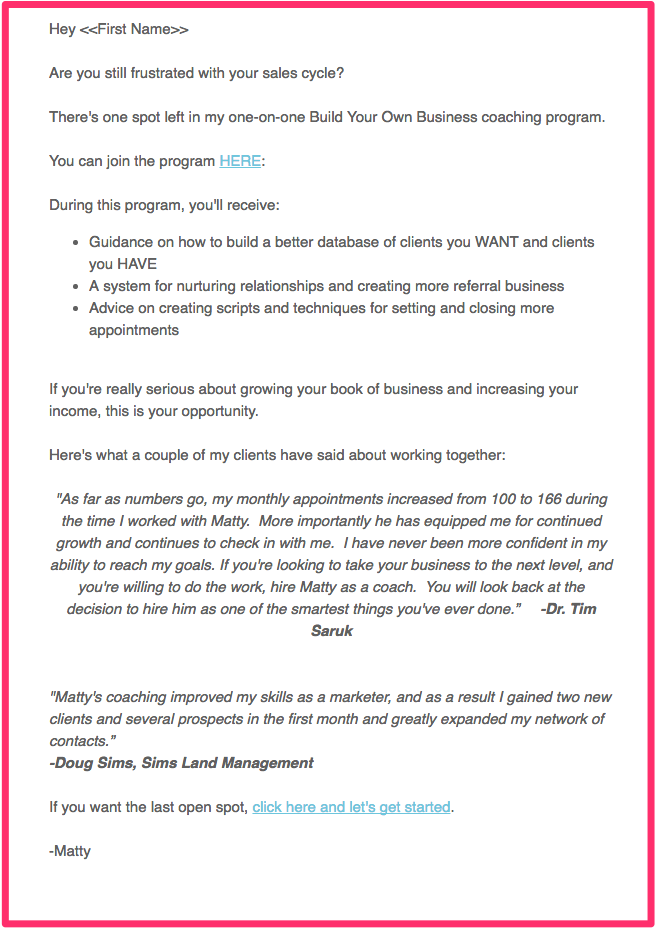
Here’s are Matty’s takeaways from launching his coaching program.
I had never formally pitched my services to my list. Sales coaching is what I’ve been doing regionally, so I was pleasantly surprised that all 4 clients who signed up were in other cities. Nobody local! And the only consistent communication with them has been my weekly email.
I realized the power of testimonies during this process. I really should have started collecting testimonials years ago. It’s obvious how powerful they really are!
Here’s the three main takeaways that I got from Matty’s story:
- If you don’t have an email list yet to launch your coaching program to, get one. Ask your friends and family and follow up like crazy, do what it takes. Make this your number one priority for the next 3-4 weeks and see what you are capable of.
- Always be collecting stories. Keep on ongoing Evernote file or a document on your computer that includes screenshots with the success stories of your client. If you don’t have success stories, ask for them.
- Don’t be afraid of a small list. Just because your list is small, doesn’t mean that you can’t have big results. Just go out there and try. As Matty says, “Just do it and see what happens. You have nothing to lose”.
That’s great. I have NO list. Do I still have to wait until I have a list to launch a coaching program?
What if you don’t have an email list at all, is this still doable?
Yup!
Obviously, I recommend growing an email list first. Growing a list, building a relationship with that list and serving that list by offering products that solve real problems is the single most effective way to grow a business.
But if you need to move quicker and generate some revenue so that you can dedicate more time to growing your list, there is an alternative approach.
Two steps to launching a coaching program without a list:
1. Make a list of the 50 people you’re the closest to
2. Get that list of 50 people to help you get your first client
Here is how that works…
Step #1 Make a list of the 50 people you are the closest to.
You’ve created a coaching program that you know others can benefit from. Now, you need get people to know that it exists.
The single easiest way to do this is by telling people you already know about the program.
Think about your network of friends and family in two sections:
Section #1: People that are likely to need your coaching service
Section #2: People that know people that need your coaching service
You don’t want to be the weirdo pitching essential oils to all your friends. There is an easy way around that.
But you also don’t want to avoid asking the people that like you the most not to help you.
So here is what we’re going to do…
1. Make a list of 50 people you are close to
These are the people that you are going to be doing personalized outreach to.
Here’s a worksheet we created to help you keep track of your contacts.
Where do you find these connections? Here’s a list where you can start looking:
• Your phone contacts
• Your Facebook friends
• Your Instagram followers
• Your Twitter followers
• Your LinkedIn Connections
• The people that you’ve emailed in the last 90 days
• Local networking groups you are a part of
• FB and Slack groups of courses or books you’ve purchased
This is what your worksheet will look like:
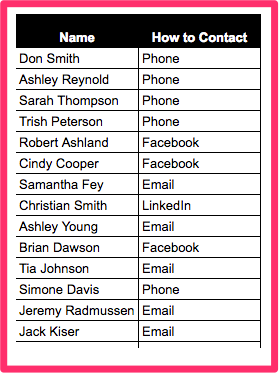
Made your list? Good.
2. Categorize each person as customer or referer
Now go through the list you just created and classify everyone in one of three categories:
Category #1: Customer – This is someone who has interest and a need in the area that you coaching program covers.
Category #2: Referral – This is someone who doesn’t have a need in the area of your coaching program but you are close to them and you have a reasonable gut intuition that if you asked them for help they might refer you to a friend that does (as long as you don’t make them think you’re selling some weird MLM product in the process).
Category #3: Delete – This is for someone who doesn’t fall into either of the above categories. They aren’t likely to be a customer at all and they are more likely to tell you to never talk to them again than to refer someone to you (even if you ask for the referral in a non-weird kind of way)
Your ‘delete’ group should have no more than 10 people in it. If it has more than 10, then revisit the 50 people you included in the group to begin with.
This is what your worksheet will look like:
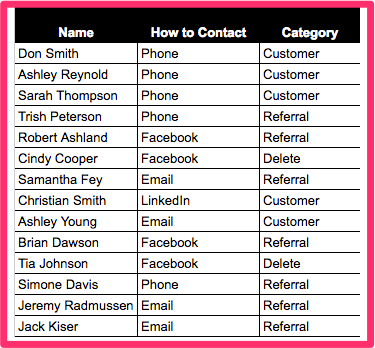
Step #2 Get that list of 50 people to help you get your first client.
Now it’s time to ping each person.
This step is really important.
Your goal is one of two things:
Goal #1a: Get your good prospects to hire you
Goal #1b: Get your good friends to refer you to a good prospect who will hire you
If you navigate this step likely, it’s extremely likely that 2-3 people on your list will hire you to coach them.
The key part of this step is to not come across like a weirdo when pitching this and to give people an easy way to say no so your long term relationship with that person isn’t damaged as a result.
The way you do this is to use a two step approach.
This is what it looks like…
How to get your good prospects to hire you
Anyone you’ve marked in your worksheet as a ‘customer’ I recommend taking this two step approach.
First, contact them and ask them for their advice.
Here is the basic script you can use for that:
<pitching a health coaching service>
Hey dude!
Hope the big conference went well last weekend. Looking forward to hanging tomorrow!
Quick question: Last week we we’re talking and I mentioned some of the health stuff I’ve been working on this year. Thanks for your support on that.
Our convo triggered an idea, and I wanted to get your advice/opinion on it…
I would like to start a coaching program to help people do the same thing I’ve been doing (create habits out of eating healthy and exercising more).
I’m thinking the program would like something like this:
• We’d establish a #1 goal for the next 90 days (that might be a weight goal, exercise goal etc)
• Then we’d come up with 1-2 super simple daily actions they could take to hit the goal
• Once a week I’d have a 30min call with each person in the program
• We’d outline their meal plan and exercises for the week
• Each day I’d send a text to check in on their progress
• Each person could ask questions of me personally 24/7
I’m thinking it would cost around $50-100 per month
What’s your general opinion on that idea?
Think it would be helpful for folks? Anything you’d add/takeaway?
Thanks dude!
-Bryan
Note: Be sure that at this step you keep the object of the coaching program a 3rd party. Don’t say, “Once a week we would have a 30 min phone call”. This easily can turn this into feeling like a veiled pitch to the person, you don’t want that.
The purpose of this step is 100% what you are asking in the email. It’s not to sell them. It’s not to pitch them. It’s to get their opinion on the program.
The cool part is, that without even asking, you’ll get a very good sense of someone’s interest level based on their response to this message.
There are 3 classifications of potential responses to this message:
Classification #1: No response – If someone doesn’t respond back to this, follow up. But do it on another channel.
Meaning, if you emailed this out. Send them a quick text. But don’t be weird or aggressive at all.
Also, give them time. 5-7 days at least before following up.
Remember, above all, preserve the relationship
Classification #2: Lukewarm response with no real substance – If someone responds with a message like, “That sound cool” That is a lukewarm response.
That means they aren’t super interested and most 9/10 times they aren’t interested in the program.
Thank them and move on.
Classification #3: Super detailed feedback with perceived interest – If someone responds back with 2 paragraphs of notes and heavily indicates they are interested, this is someone you want to follow up with.
That would look like this:
Hey Bryan!
Dude, I love this idea so much. I really thought about our conversation last week a lot and how much I need to be doing what you’ve done.
Re: feedback – here are a few idea I have…
[idea #1]
[idea #2]
[idea #3]
Hope that helps!
– Ryan
Out of your original worksheet of 50 people, you should have 2-5 people fall into this category. These are the people you want to focus on.
The next step is to offer these people a free week in the program if they fit these three criteria:
Criteria #1: Did they indicate or insinuate a heavy personal interest in the program?
Criteria #2: Do you think they would join if you made it easy for them?
Criteria #3: Do you think you could genuinely help them?
If you’re answer to all three is yes, move to the next step. If the answer is no, change that person’s category to ‘referral’ and come back to them.
This is what that message would look like if your answer to all three questions was yes…
Hey Ryan!
Thanks so much for the ideas!
[respond to each idea they gave by affirming them – not necessarily agreeing to do them but affirm them]
I’m really excited by the idea of doing this!
Not sure if you’d be up for this but I had an idea…
What if you were my first coaching client? I wouldn’t charge you anything of course, but I’d love to give this a try and who better to start with?
We could try it out for a week, see if we both dig it and if so, talk about what it might look logn term then.
Totally understand if you’ve not comfortable with that, but thought I’d throw it out there.
No worries if not.
Just let me know.
Thanks!
-Bryan
Sidenote: Relationships are the single most valuable thing in life. Don’t use these scripts word for word. Re-write these messages in your own language and adapt them for whatever medium you typically talk to that person in.
If you normally text this person, text them – don’t email.
If you normally call this person on the phone, call them.
Use these scripts as a guide..
How to get your good friends to recommend someone that might be a good prospect
Now…
What do we do with people we know don’t need our coaching but like us and might be able to intro us to people that are interested?
We take the same approach as above, only our call to action is slightly altered.
First, contact them and ask them for their advice (same as above).
<pitching a health coaching service>
Hey dude!
Hope the big conference went well last weekend. Looking forward to hanging tomorrow!
Quick question: Last week we we’re talking and I mentioned some of the health stuff I’ve been working on this year. Thanks for your support on that.
Our convo triggered an idea, and I wanted to get your advice/opinion on it…
I would like to start a coaching program to help people do the same thing I’ve been doing (create habits out of eating healthy and exercising more).
I’m thinking the program would like something like this:
• We’d establish a #1 goal for the next 90 days (that might be a weight goal, exercise goal etc)
• Then we’d come up with 1-2 super simple daily actions they could take to hit the goal
• Once a week I’d have a 30min call with each person in the program
• We’d outline their meal plan and exercises for the week
• Each day I’d send a text to check in on their progress
• Each person could ask questions of me personally 24/7
I’m thinking it would cost around $50-100 per month
What’s your general opinion on that idea?
Think it would be helpful for folks? Anything you’d add/takeaway?
Thanks dude!
-Bryan
There are a few potential responses to this message:
Response #1: No response – For people that don’t respond within 5-7 days, you can give them a gentle nudge. But don’t be aggressive here at all.
Response #2: Light response – For people that respond, but don’t give you much feedback, slow play them. Don’t push them hard or move to the next step. Instead, next time you have an interaction with them outside of the context of this interaction, bring up the subject again and prod them for me detail.
That might look like you bumping into them at a BBQ a few weeks later. When you do, somewhere in your convo, bring up your coaching program and try to get them to give you feedback.
Remember, your #1 goal of this step is to get legit valuable feedback from your friends.
You want them to be invested in it. You need to ignore 90% of the actual advice you get, but the valuable part of this step is getting those closest to you to invest in you by helping you.
This might sound weird or like we’re trying to play with people, but it’s not at all. It’s basic human behavior. We’re just being 1% more intentional about it than most people.
Response #3: Heavy response – For people that respond with lots of details, enthusiasm and support.
Anyone that gives you enthusiastic response and support, focus on them! Don’t get bogged down with all the lackluster responses and no responses. Focus on the 10% of people that are enthusiastic and take the time to give a well thought out response.
Respond to them with this basic approach:
Hey Ryan!
Thanks so much for the ideas and support!
It means more than you know
I’m really excited about doing this and definitely am moving forward.
I had an idea on how I might start…
I’d love to get my first coaching client by offering my services for free. Try it out for a week or two, see if my clients is getting awesome results and if I’m enjoying it.
What do you think?
Do you happen to know anyone that might be interested in me coaching them for free?
No worries if not.
Thanks!
-Bryan
…
With both of these groups, your approach is this:
1. Get the person personally invested (although small investment) by giving you feedback and advice
2. Then asking them to either become a client for free for 1-2 weeks or to refer someone to you
This is an extremely effective approach because it doesn’t feel weird to people and it gets them on your side before you ask them for anything.
However, our goal of this isn’t to get a free coaching clients. The goal is to get people to pay us money in exchange for us helping them.
So how do we transition from free to paid?
Easy.
Make those 1-2 weeks of free coaching be the most incredible 2 weeks of their like.
Then, ask them to pay.
🙂
Here is how that conversation might go (this wouldn’t take pace on email, it should happen on a call, but I’ll use email here because it’s easier to show in a blog post).
Hey Ryan,
Dude, these last 2 weeks have been awesome!
Our #1 goal for these 2 weeks was to help you lose 5# and we you did it! Great work!
I know your BIG goal is to lose 50# and this was an incredible start.
Thanks so much for being my first client, I really enjoyed it!
I would absolutely be interested in working with you going forward,
Would reaching your goal of losing 50# be worth $100 per month to have me there with you holding you accountable and helping you along the way?
Click here to signup
-Bryan
Alternative Approach: Prospect in relevant Facebook groups.
Another strategy you can use to sell your coaching program is to post in Facebook groups. Facebook groups are a great way to find people who are connected to a single topic.
Here’s what you’ll do:
1. Find Facebook groups relevant to your topic (or filled with your ideal client).
Where are the people that would be the perfect fit for your product hanging out?
• If you are selling a health coaching program, they are probably hanging out in fitness related groups.
• If you are selling a coaching program to increase business sales, they are probably hanging out in entrepreneurial groups.
• If you are selling a coaching program for parents, they are probably hanging out in mom / dad/ parenting groups.
Search for groups where your ideal client is hanging out, and then join those groups.
2. Read the group rules.
Every Facebook group has it’s own rules, and a lot of them won’t allow your self-promotion. Make sure you read the rules of the group before posting your program. Some groups allow promotion on certain days or on certain promo threads. Just know when and where you can post about your program so you don’t get kicked out of the group.

3. Post about your coaching program.
You’ve found a group filled with your ideal audience and you’ve read the group rules. Now, you’ll want to post about your program. I suggest using some of the techniques from the email above – like having a testimonial and spelling out the details of your program.
Here’s what a post might look like:

Abbey sold 3 of her coaching packages with this method and is now bringing in about $600 a month in reoccurring monthly revenue. She has only been in business a few months and now has the funds to keep growing her email list for her virtual assistant coaching business.
Want our swipe file + action items?
Whether you have a large email list, a small list, or no list at all – starting a coaching program can be a good option for you.
To recap, here is a quick rundown of how I started our coaching program and how you can do the same thing:
Step #1: Pick the exact problem your coaching program will solve.
Step #2: Decide on the structure of your program.
Step #3: Collect 2 stories from people you’ve helped.
Step #4: Decide on your pricing structure.
Step #5: Set up your internal processes and systems.
Step #6: Launch your coaching program to your list
If you don’t have an email list or have a very small list, here are two additional ways you can promote your program:
Step #1: Make a list of 50 people you are closest to.
Step #2: Get that list of 50 people to help you get your first client
Alternative Approach: Prospect in relevant Facebook groups
I’ve put together a sweet little swipe file that contains my coaching program launch emails as well as 3 other important emails we use during our program, along with our on-boarding process.
If you want to grab a copy of those, just click here.
